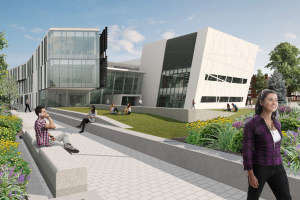Sep 27 2013
Cancer research in Manchester is going green thanks to the North West’s latest research building, which has been carefully designed to incorporate a range of environmentally-friendly features.
 The new Manchester Cancer Research Centre (MCRC) building
The new Manchester Cancer Research Centre (MCRC) building
Environmentally-friendly features on the new Manchester Cancer Research Centre (MCRC) research building, due to open in summer 2014, include walls which clean themselves using rain water and disperse smog.
The building, which will house leading cancer specialists from The University of Manchester, The Christie NHS Foundation Trust and Cancer Research UK, will also make the most of the North West’s weather. It includes a rainwater harvesting system to collect and recycle rainwater and use it to flush the lavatories in the building - saving around one-third of the water needed for flushing every year.
Professor Nic Jones, MCRC Director, said: “The new Manchester Cancer Research Centre has been designed to provide state-of-the-art facilities to carry out the pioneering cancer research essential for future breakthroughs that improve patient treatment.
“It has also been designed to be as cost-effective as possible by incorporating environmentally-friendly features that help to keep running costs to a minimum.
“By taking environmental factors into account right from the start of the project, we hope to deliver a sustainable, efficient building that meets the research needs of our scientists.”
The MCRC building includes high-tech aluminium cladding which has a special self-cleaning EcoClean™ coating. Using UV radiation from the sun, it helps attract rainwater and breakdown pollutants. Organic matter such as moss and algae, which usually stick to buildings and can accelerate corrosion, are also washed away more efficiently thanks to its slippery surface.
The design also includes photovoltaic panels for generating electricity, solar thermal panels to produce hot water and an extensive range of metering in the building so that energy use in different area can be monitored separately and optimised.
There is also a central lightwell to allow daylight to penetrate through the centre of the building and reduce the amount of artificial lighting required during the day. The lightwell roof glazing has been carefully orientated to minimise the penetration of heat from the sun and help reduce the associated cooling costs.
Emma Gardner, Head of Environmental Sustainability at The University of Manchester, said: “Ensuring sustainability and minimising ongoing running costs were important considerations for the new research centre. The design of the walls, floors, windows and roof all exceed current regulations while the building fabric specification surpasses current air tightness requirements. These features will help to limit heat loss and reduce the energy consumption of the new building.”
Good ventilation and temperature control has also been taken into account with laboratories located on the south side of the building with limited external glazing to keep the sun out and the laboratories cool.
Office space has been arranged on the north side of the new building away from the most intense solar heat and will have full height glazing and external ventilation grilles to maximise the use of natural light and ventilation. Overall, some 85% of the offices will be naturally ventilated along with 25% of the open plan office accommodation.